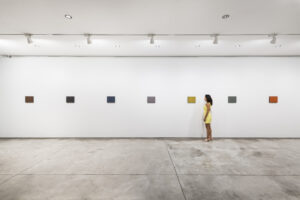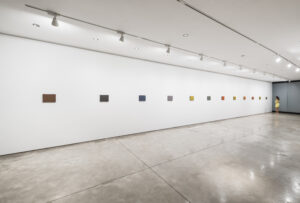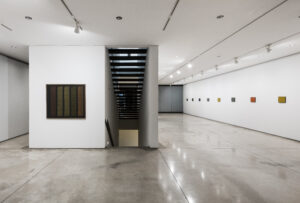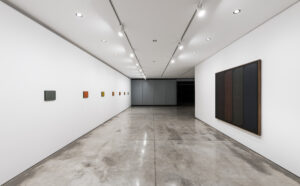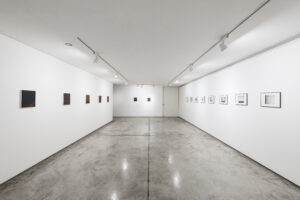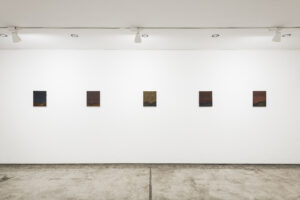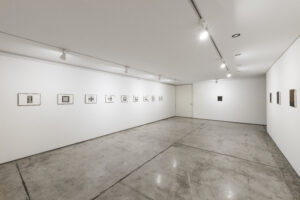joão trevisan_ the dorsum of the tiger
nov 11_ 2023 - jan 27_ 2024

Time is the substance of which I am made.
Time is a river that sweeps me away, but I
am the river; it is a tiger that tears me
apart, but I am the tiger.
Jorge Luis Borges, A New Refutation of Time, 1952
The image of the tiger, with its undefined form, sinuosity, and strength, accompanies my gaze as I observe João Trevisan’s work. Interestingly, it is also the artist’s sign in the Chinese zodiac; he has a fierce tiger tattooed on his skin. His most recognizable works, the Intervalos [Intervals], feature brindle patterns. The enigmatic animal also appears as a character in intriguing narratives that serve as titles for some of his paintings, alluding to themes of bodily exhaustion, discipline, and intense focus. In Buddhism, a philosophical and spiritual tradition that Trevisan wholeheartedly embraces, the tiger is associated with generosity, robustness, and wisdom. As I walked with Trevisan through the hills surrounding the railway where he dedicates part of his work in Brasília, during the two years of research preceding this exhibition, I felt as though I were accompanied by a tiger. Silent, vigilant, with determined and steady footsteps, I was reassured that he knew the terrain as intimately as the stripes on his own back.
This shifting dorsum, where bones move beneath vibrant skin, creating an almost fixed silhouette reminiscent of mountains dominating a silent horizon, resembles Trevisan’s landscape paintings, which are exhibited for the first time on this occasion. Its vertical framing aligns with Eastern artistic traditions related to Buddhism, akin to folding screens depicting long riverbeds, offering a chance for contemplation of the horizon through verticality. Unlike the plateau on which Brasília is situated, the city of the artist’s birth and residence, his landscapes evoke introspective places intertwined with personal memories, such as the loss of his father or family trips to the mountains. Sharp earth volumes ascend, forming a protective barrier around a placid, contemplative lake – a mental sanctuary of imagined refuge. They beckon you to take a silent walk to explore what lies behind a mountain, to discover a lost paradise. Like this oasis, ever-present but not always visible, the tiger sinuously dances, over the ridges that mimic its back, in sheets of water that shimmer with its accurate walk.
In these previously unseen monochromatic paintings, Trevisan explores various ways in which light and color can be perceived by the human eye. He superimposes and juxtaposes chromatic blocks, conducting a profound analysis of the written and painted works of Josef Albers (1888-1976). These paintings demand an oblique perspective of the tiger in its hunt – skewed yet precise, revealing not only intricate details about the behavior of light but also offering glimpses into Trevisan’s own essence, in a mirror of his concerns about time and perception in the making of the works. He arranges his vertical bodies and covers them with a color fog that, due to these concerns and configurations, brings the works closer to the realm of still life, be it that of Josefa de Óbidos’s (1630-1684), through the luminous and waxed veil of the technique à la candela, or that of Giorgio Morandi’s (1890-1964), for the embalmed, pasty light that tends toward monochromy. The luminous expansion and irradiation of colors in an introspective painting leave the monochromes open, occupying the space freely, without the wood that outlines the Intervalos series.
Governed by silent rhythms, discernible only through the keen perception of the gentle tremors created by feline paws on the red earth, Trevisan’s Intervalos are reimagined here with new concerns and experiments in encaustic. In these pieces, he paints vertical forms – similar to the wooden sleepers that the artist uses in his large sculptures – in repeating intervals along the horizon, now with uniform widths and spacings. Within these recurrent bodies, even in their distinctions, one can perceive the accurate vertical brushstrokes with which Trevisan not only manipulates the colors but also shapes relationships with light throughout the creation of the paintings. The brush bristles model tiny hills and valleys of oil paint, resembling the unique grains in the wood, the scars on the sleepers of his sculptures, or the gleaming texture of a tiger’s fur, bathed in the silver moonlight, on its dorsal surface.
Silence, discipline, and the pursuit of clean thinking are encapsulated in the painting process that employs time as an elementary material: each artwork has around thirty overlapping layers, from initial preparation to the final glaze, with drying intervals spanning several days between each application. Precision is also employed in the placement of wood, creating a three-dimensional element that refuses to be just a frame; instead, it accentuates the artwork gravity and reinforces its introspective nature. Similar to a devotee who faithfully visits the same temple every day, Trevisan refines, through repetition, a painting technique that continually evolves, deep within the jungle, immersed in his craft.
Amidst the nocturnal works, paintings on paper make their debut appearance. The decision to utilize a clear and porous surface, contrary to his usual practice, represents an expansion of visual grammar through its inversion, a complement achieved through opposition. Whereas the Intervalos explore the material’s capacity to hold light or actively engage with it, the Interseções [Intersections] paper series delve into the fading of an already absent light, of a grazing penumbra. They do not ask the viewer to move around them to reveal their multiple possibilities of luminous dialogues, akin to a tiger encircling and observing its prey. Instead, they resemble traces of a rudimentary photograph, capturing the movement of light in a fleeting moment. These artworks leave us with the enigma of the intersections of dense black oil paint and extremely light paper, like the silent tread of a tiger with purposeful steps. The spectral, diffuse, and drawn-out shapes corroborate this effect: shadows through which daylight seeps and grainy moonlight infiltrates, fissures of light that sear and fade a surface. In these pieces, Trevisan proposes a glaze that seals no painting other than the support itself – or even the light itself.
Trevisan’s insistence on exploring silence, time, and light through matter mirrors the tiger that tames its own restlessness, in eternal change. It achieves a profound presence through meditation, where silent exchange occurs through gaze, and language flows in sensitive muteness. Once impenetrable, now vulnerable, the tiger awaits attentively and respectfully for the insurmountable time of things, watching their transformations lurking in the half-light. It brings together strength and lightness as it stands firm in the face of the blinding light and the darkness that advances without fear. Lulled by songs of renovation, it reveals its yet-to-be-built memories as real as its back, whose sinuosity invites you to stroke it with your hand. To see the acute silence and to touch the sweet light is to have a mind clear as the meadow.
Mateus Nunes
Curator
Note: The title of the exhibition is a homage-quote to the philosopher Benedito Nunes (1929-2011), for his book titled O dorso do tigre [The Back of the Tiger], published in 1969. Nunes refers to an oscillating state of Western culture based on unstable foundations, illustrating it like the back of a tiger.
exhibitions images
